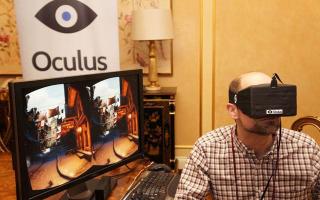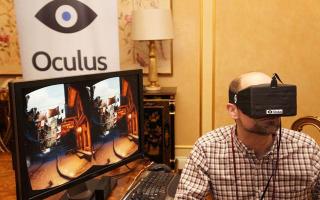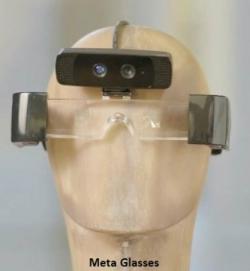Oculus Rift : You Read about It Here First - and Why Glyph May be Even Bigger

Last July, MyersBizNet Media Business Report corporate members learned about Oculus Rift, which made the news recently when Facebook acquired the company and its immersive virtual reality technology for $2 billion. Members of MyersBizNet learn early about emerging technologies and tech companies that will impact media and marketing. In February, just a few weeks before the Oculus Rift acquisition, we suggested that members pay close attention to the virtual reality and virtual video space, focusing our attention on Glyph, a Kickstarter project that we believe could be even more important as a marketing and content distribution advance than Oculus Rift. We're re-publishing both reports below. Read the weekly MyersBizNet Media Business Report for our regular first-look advisories on new media technologies and tech companies to watch.
Oculus Rift- Changing the Gamer's World
There have been many wearable gaming headset devices that have tried to achieve a fully immersive virtual reality experience, dating back to the Nintendo Virtual Boy. They all had serious flaws that prevented market adoption. The introduction of the Oculus Rift is changing all of this. Though the first model used a 5.6" screen, the newer designs utilize a 7" screen with two eye holes. Though slightly bulky, it's lightweight enough to avoid neck strain. In fact the entire device weighs only about a pound, which is significantly lighter than any previous gaming headset. The device wraps around the head and allows the user to even see the game from their peripheral vision. According to Brendan Iribe, the CEO of Oculus VR, the great peripheral vision is what tricks the brain into believing the game is reality. Most importantly, any game can be transformed to 3D with Oculus Rift, even games like Portal 2, which were not developed for 3D. One person experimenting with the unit said that the vines on the wall were the only aspect of Portal 2 that did not look 3D. Along with this, you can look around a room simply by moving your head rather than having to use controls, adding to the authenticity of the experience. An accompanying controller is available and for a more immersive experience, the Razor Hydra add-on offers the ability to use your hands as joysticks. This headset can also be used for watching TV, creating an immersive experience for TV shows, sporting events and advertising. It can even be used by advertisers for more effective commercial engagement and product demonstrations. While many pundits are writing off 3D video, the growing popularity of gaming (with more than 80% of all those under 25 years old actively playing mobile and console games) Oculus Rift will offer marketers new opportunities to reach consumers in a completely immersive virtual environment they can control.
bulky, it's lightweight enough to avoid neck strain. In fact the entire device weighs only about a pound, which is significantly lighter than any previous gaming headset. The device wraps around the head and allows the user to even see the game from their peripheral vision. According to Brendan Iribe, the CEO of Oculus VR, the great peripheral vision is what tricks the brain into believing the game is reality. Most importantly, any game can be transformed to 3D with Oculus Rift, even games like Portal 2, which were not developed for 3D. One person experimenting with the unit said that the vines on the wall were the only aspect of Portal 2 that did not look 3D. Along with this, you can look around a room simply by moving your head rather than having to use controls, adding to the authenticity of the experience. An accompanying controller is available and for a more immersive experience, the Razor Hydra add-on offers the ability to use your hands as joysticks. This headset can also be used for watching TV, creating an immersive experience for TV shows, sporting events and advertising. It can even be used by advertisers for more effective commercial engagement and product demonstrations. While many pundits are writing off 3D video, the growing popularity of gaming (with more than 80% of all those under 25 years old actively playing mobile and console games) Oculus Rift will offer marketers new opportunities to reach consumers in a completely immersive virtual environment they can control.
Researcher Steve Lavelle writes at the Oculus Rift blog, "We have all learned that latency is the bane of virtual reality. Because your head freely rotates, presenting the correct image to your eyes is like firing a bullet at a moving target. The target is "sighted" by sensor fusion software, which provides the direction you are currently looking. Latency is the time it takes between your head moving to a new orientation and the correct image arriving on your retinas. In real, old-fashioned reality, the latency is effectively zero. In VR, latency is widely recognized as a key source of disorientation and disbelief (the brain cannot be fooled)." Lavelle argues "that simple prediction techniques can reduce latency so much that it is no longer the main problem. Simply present the image that corresponds to where the head is going to be, rather than where it was."
While the main group that is interested in this product is the gaming community, there are other applications. The Interactive Media Systems Group at Vienna University of Technology uses the virtual reality to help train amputees how to function with their new prosthetics. Surgeon Simulator 2013 has been converted from PC use to the Oculus with much success. Other applications include law enforcement training to driving instruction.
While you will not be able to wear glasses with the device, it will have the option to change the distance to accommodate for near sighted and far sighted individuals. There has not been a lot of information given on the extent to which this will work, just that they are trying to make it usable for those without perfect vision. However, those with severe astigmatism may not be able to use the device as it will not give complete correction. It is also interesting to note that the unit will not cause eye strain.
Currently the only option to purchase Oculus Rift is the developer's kit, which costs $300. The release date for the consumer model has yet to be set, though most speculate that it will be available in 2014. While active gamers can buy the developer kit, the average consumer will want to wait. The consumer edition will feature improved immersion, comfort and viewing experience.
Glyph Goes Beyond Oculus Rift
Wearable devices that offer audio and video have had one issue holding them back so far: traditional screens that are close to the eyes have resolution that ranges from mediocre to bad. But, Ann Arbor-based Avegant (www.avegant.com), the creator of Glyph, a new personal theater device, has solved the problem in a surprising way: they modeled their display on the workings of the human eye.
solved the problem in a surprising way: they modeled their display on the workings of the human eye.
The display works by projecting images directly onto the wearer's retina. Each eye piece contains 1 million micro-mirrors and a low-power LED. The result is an extremely sharp image. The light is similar to natural light, so it does not cause eye strain in wearers.
The headset also features an innovative design: it can be worn as headphones, delivering high-fidelity audio. When the wearer wants to incorporate video, she simply pulls down the headband so that it covers her eyes. The headphones feature advanced noise cancelation, allowing the wearer to enjoy a distraction-free viewing experience. (See our earlier reports on Google Glass and Oculus Rift. Send your member's site password request here.)
The project, as more and more cutting-edge technologies are, is being funded through Kickstarter. Supporters who give $499 or more will receive a Glyph headset of their own in blue, black or white. The project is proving extremely popular. It took a mere four hours for the project to meet its $250,000 goal. As of this writing pledges have passed $1.2 million with two more weeks in the campaign. Among supporters, 1,860 have selected support levels that entitle them to the revolutionary headsets. You can watch the video and order your Glyph, due to be delivered in December, at http://kck.st/M4Zw9f
The project has been in the works for over two years. The first prototype was a coffee table-sized device you had to stick your head in in order to view images. The current physical alpha model is a wearable size. They are using the Kickstarter funds to create a beta that will be lighter and slimmer. The Glyph beta is expected to weight 16 ounces and provide WXGA video at a 120 Hz refresh rate.
Outside of the immersive experience, the Glyph has a number of advantages over current mobile video devices. The screen uses far less power than the one on a tablet or smart phone. Avegant CEO Edward Tang told International Business Times that the device will allow users to watch three hours of video without recharging. Plus, while digital screens on smart phones can be hard to see in bright light, the Glyph blocks out ambient light so that it can be used indoors or outdoors, no matter how bright or dark the environment.
The device is powered through a micro-USB and receives video through a standard HDMI cable. Wearers can stream movies from subscription services like Amazon Prime Video or Netflix through laptops, tablets or iPhones, or, watch videos that they already own. The device is also intended to create a fully immersive video gaming experience.
The creators have exciting ideas for the future of the Glyph, as well. They expect that film directors can use the device to create 360 degree immersive film experiences. In future models, they hope to incorporate chips that allow you to make phone calls directly from the headset and cameras so that you can film what is around you.
All of these, and the Glyph beta itself, are still in the future. While the Glyph, in its first incarnation, will not offer all of the utility of a device like Google Glass, its innovative display technology still makes this a device to watch.


